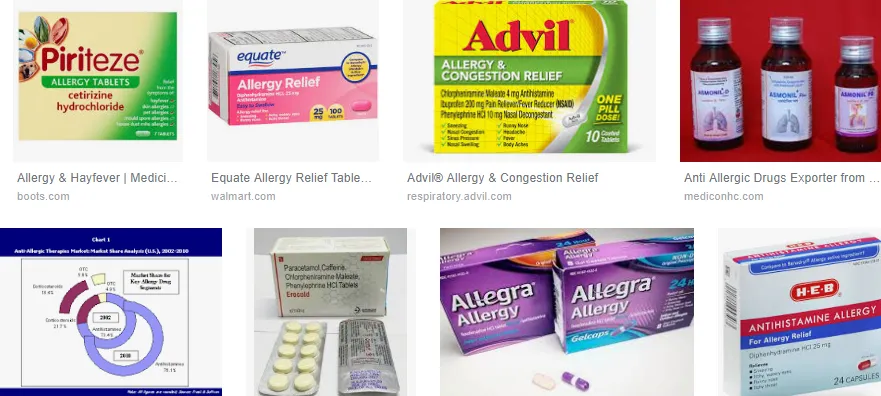
Anti-allergies listed in essential medicine list include;
--Chlorpheniramine maleate, Cetirizine Hydrochloride, Loratadine, Promethazine hydrochloride, Adrenalin, Hydrocortisone, Dexamethasone and Calamine lotion
Indications of drugs with anti-alergies properties are;
oChlorpheniramine maleate is used in symptomatic relief of allergy such as hay fever, urticaria; emergency treatment of anaphylactic reactions
Cetirizine Hydrochloride, Loratadine are used in symptomatic relief of allergy such as hay fever and chronic idiopahtic urticaria
oPromethazine hydrochloride is used in symptomatic relief of allergy such as hay
fever and urticaria; emergency treatment of anaphylactic reactions; sedation nausea and vomiting
Adrenalin is used in emergency treatment of acute anaphylaxis, angioedema and cardiopulmonary resuscitation
Hydrocortisone is used in adrenocortical insufficiency, hypersensitivity reactions e.g. anaphylactic shock and angioedema asthma, severe inflammatory bowel disease, haemorrhoids and rheumatic disease
Dexamethasone is used in suppression of inflammatory and allergic disorders, diagnosis of Cushing’s disease, congenital adrenal hyperplasia, cerebral oedema associated with malignancy, nausea and vomiting with chemotherapy
Calamine lotion is indicated for pruritus
Contraindication of Anti-allergies
Most individual drug which can be used as anti-allergies has different properties which make them to be contraindicated to patient with some specific conditions.
Chlorpheniramine maleate like many antihistamines it should be avoided in acute porphyria
Cetirizine Hydrochloride and Loratadine like many antihistamines they should be avoided in acute porphyria they should also be avoided in pregnancy and breast-feeding
Promethazine hydrochloride like many antihistamines it should be avoided in acute porphyria
Hydrocortisone and dexamethasone are contraindicated to patients with systemic infection (unless specific therapy given):
Live virus vaccines should also be avoided due to possible suppression of immunity because serum antibody response diminished)
Dose, Dosage and Course of Anti-allergies
Chlorpheniramine maleate
By mouth, 4 mg every 4–6 hours, max. 24 mg daily Children, 1–2 years 1 mg twice daily; 2–6 years 1 mg every 4–6 hours, maximum 6 mg daily; 6–12 years 2 mg every 4–6 hours, max. 12 mg daily
By intramuscular injection or by intravenous injection over 1 minute, 10 mg, repeated if required up to 4 times in 24 hours; CHILD under 6 months 250 micrograms/kg (max. 2.5 mg), repeated if required up to 4 times in 24 hours; 6 months–6 years 2.5 mg, repeated if required up to 4 times in 24 hours; 6–12 years 5 mg, repeated if required up to 4
oCetirizine Hydrochloride and Loratadine
ADULT and CHILD over 6 years 10 mg once daily; CHILD 2–6 years 5 mg once daily
Promethazine hydrochloride
By mouth, 10–20 mg 2–3 times daily; CHILDREN under 2 years not recommended, 2–5 years 5–15 mg daily in 1–2 divided doses, 5–10 years 10–25 mg daily in 1–2 divided doses
By deep intramuscular injection, 25–5mg; max.100 mg; CHILD 5–10 years 6.25–12.5 mg
By slow intravenous injection in emergencies, 25–50 mg as a solution containing 2.5 mg/mL in water for injections; max. 100 mg
The drug should be administered twice daily for not more than five days
Adrenalin
Acute anaphylaxis, by intramuscular injection of 1 in 1000 (1 mg/mL) solution.
Acute anaphylaxis when there is doubt as to the adequacy of the circulation, by slow intravenous injection of 1 in 10 000 (100 micrograms/mL) solution
Hydrocortisone
By mouth, replacement therapy, 20–30 mg daily in divided doses, CHILDREN 10–30 mg
By intramuscular injection or slow intravenous injection or infusion, 100–500 mg, 3–4 times in 24 hours or as required; CHILDREN by slow intravenous injection up to 1 year 25 mg, 1–5 years 50 mg, 6–12 years 100 mg
Dexamethasone
By mouth, usual range 0.5–10 mg daily; CHILDREN 10–100 micrograms/kg daily
By intramuscular injection or slow intravenous injection or infusion (as dexamethasone phosphate), initially 0.5–24 mg
CHILDREN 200–400 micrograms/kg daily Cerebral oedema associated with malignancy (as dexamethasone phosphate), by intravenous injection, 10 mg initially, then 4 mg by intramuscular injection every 6 hours as required for 2–4 days then gradually reduced and stopped over 5–7 days
oCalamine lotion should be applied occlusive to the affected part
Effects and Adverse Effects of Anti-Allergies
Side and adverse effects of ant allergies
Chlorpheniramine maleate and Promethazine Hydrochloride
Drowsiness
Headache
Psychomotor impairment
Antimuscarinic effects such as urinary retention, dry mouth, blurred vision, and gastro-intestinal disturbances
Other rare side-effects of antihistamines include hypotension, palpitation, arrhythmias, extrapyramidal effects, dizziness, confusion, depression, sleep disturbances, tremor, convulsions, hypersensitivity reactions (including bronchospasm, angioedema, and anaphylaxis, rashes, and photosensitivity reactions)
Dermatitis and tinnitus reported
Cetirizine Hydrochloride and Loratadine
Psychomotor impairment
antimuscarinic effects such as urinary retention, dry mouth, blurred vision, and gastro-intestinal disturbances
Other rare side-effects of antihistamines include hypotension, palpitation, arrhythmias, extrapyramidal effects, dizziness, confusion, depression, sleep disturbances, tremor, convulsions, hypersensitivity reactions (including bronchospasm, angioedema, and anaphylaxis, rashes, and photosensitivity reactions)
Adrenalin
Nausea, vomiting, tachycardia, arrhythmias, palpitation, cold extremities, hypertension (risk of cerebral haemorrhage); dyspnoea, pulmonary oedema (on excessive dosage or extreme sensitivity); anxiety, tremor, restlessness, headache, weakness, dizziness; hyperglycaemia; urinary retention; sweating
Tissue necrosis at injection site
oHydrocortisone and Dexamethasone
Mineralocorticoid side-effects include hypertension, sodium and water retention, and potassium and calcium loss
Glucocorticoid side-effects include diabetes and osteoporosis which is a danger, particularly in the elderly, as it can result in osteoporotic fractures for example of the hip or vertebrae
Other side-effects include: gastro-intestinal effects: dyspepsia, abdominal distension, acute pancreatitis, oesophageal ulceration and candidiasis
Musculoskeletal effects: muscle weakness, vertebral and long bone fractures, tendon rupture
Endocrine effects: menstrual irregularities and amenorrhoea, hirsutism, weight gain
Calamine lotion
No reported side effect so far